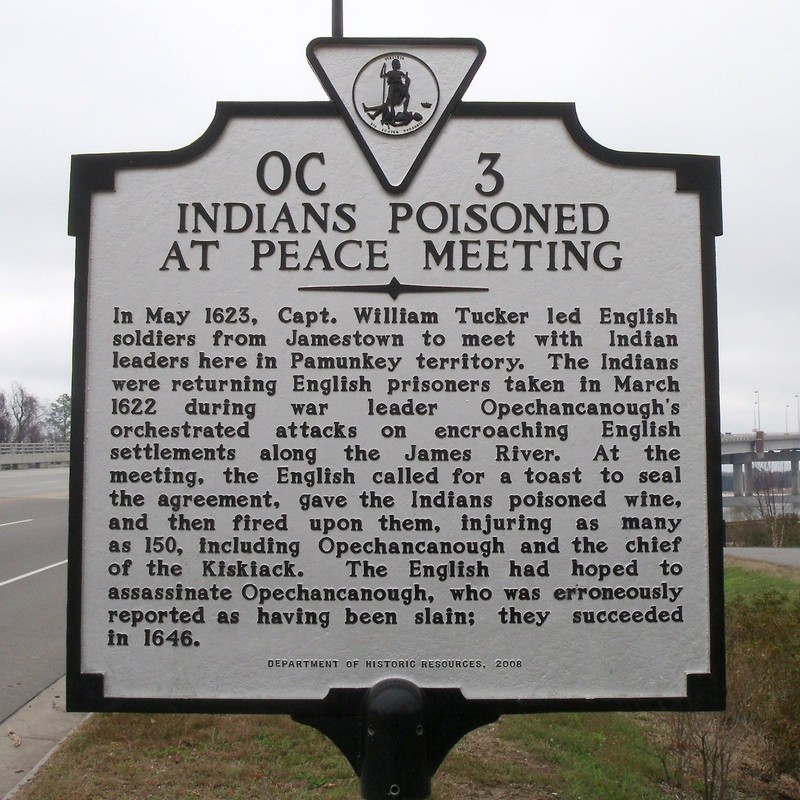Peace Meeting in King County
Introduction
Text-to-speech Audio
Images
This historical marker was dedicated in 2008 and tells the story of the duplicity of some of the area's colonial settlers. Photo by Bernard Fisher.

Backstory and Context
Text-to-speech Audio
The wine they served the Indians on the said toast, was poisoned resulting in more than 130 Indians getting sick and many were shot or stabbed to death by the soldiers. The meeting was aimed at peaceful negotiations, but owing to a lack of trust and a lack of honest intentions to negotiate in good faith, Captain Williams and his men committed mass murder.
Captain Willam Tucker was leading the group of English soldiers all the from Jamestown. During the war that took place in 1622, the Indian chief Opechancanough organized an attack on the English settlement along the James River. The poisoning attack was therefore in revenge of the attack coordinated by the Indian head, The main goal of serving the poisoned wine was to kill the Indian leader, who actually got away. Chief Opechancanough disappeared for about seven years. He was eventually killed by the English soldiers. Many Indians at the peace meeting lost their lives following the poisoning attack. Another aftermath of the attack was the tremendous decrease in population in Virginia.
The landmark is marked by the Department of Historic Resources Highway Market in Virginia near the west point. The reason for the historic landmark is the fact that the event was considered as an outstanding and shocking event. The poisoning was a shock to everyone since the meeting was meant for a peaceful negotiation (Cave 2013).
The landmark is a historical matter since it was an unexpected turn of event that shocked everyone. The many lives lost at the meeting could only be remembered using a landmark inscribed with what happened at that meeting ( Miller 2011).
Sources
CAVE, A. A. (2013). Lethal encounters: Englishmen and Indians in colonial Virginia. Bison
Books.
CHAMPION, R. (2008). From history to genealogy plus DNA. New York, iUniverse, Inc.
COLONIAL WILLIAMSBURG FOUNDATION. (2010). Jamestown, Williamsburg, Yorktown:
The official guide to America's historic triangle. Williamsburg, Va, Colonial
Williamsburg Foundation, in association with John F. Blair, Publisher, Winston-Salem,
N.C.
MILLER, D. W. (2011). The taking of American Indian lands in the Southeast: a history of
territorial cessions and forced relocation, 1607-1840. Jefferson, N.C.,
McFarland. http://ebookcentral.proquest.com/lib/concordiaab-ebooks/detail.action?docID=679315.
RAJTAR, S. (2009). Indian war sites: a guidebook to battlefields, monuments, and memorials,
state by state with Canada and
Mexico. http://search.ebscohost.com/login.aspx?direct=true&scope=site&db=nlebk&db=nlabk&AN=1026635.
TUCKER, N. (1996). Colonial Virginians and their Maryland relatives: a genealogy of the
Tucker family and also the families of Allen, Blackistone, Chandler, Ford, Gerard,
Harmor, Hume, Monroe, Skaggs, Smith, Stevesson, Stone, Sturman, Thompson, Ward,
Yowell, and others. Baltimore, Md, Clearfield Co.
Fisher, Bernard. Photograph of the Indians Poisoned At Peace Meeting Marker. Historical Marker Database. April 03, 2009. Accessed March 15, 2018. https://www.hmdb.org/PhotoFullSize.asp?PhotoID=58122.